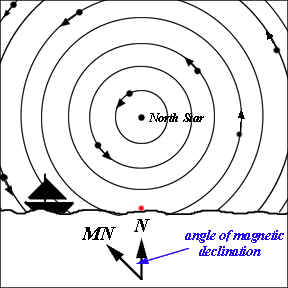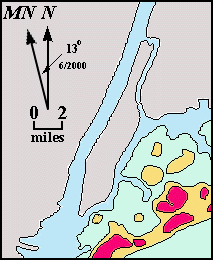

 | "A compass, Lou, has a magnetic needle which, when the compass is held level, floats freely over the center of the compass rose. The needle rotates until one end (the black end in this case) points to magnetic north and the other end (the red) points to magnetic south!" |  |
 | "You do make things difficult! I thought a compass needle points towards North! Now you're telling me it points somewhere else! Oh well, I know when I'm beaten! I better buckle down and find out about... magnetic north!" |
 | "How can you find out what the magnetic declination is at a particular location since it varies from place to place?!" |
 | "Not so difficult! If you know the direction of true north from looking at the North Star, then you can point the N on the face of the compass in that direction (to the place on the horizon directly beneath the North Star - the red dot). Then you can see the angle between the black end of the needle (which points to magnetic north) and the N on the compass face!" |  |
 |  | "If the compass was level and you were looking down at it, this is what you'd see! The north arrow on the compass rose (the large N) is pointed towards the place on the horizon directly beneath the North Star! That is, towards true north! And the needle (of course) points towards magnetic north! So the magnetic declination for this locality is 45 degrees west!" |
 | "I could do that!" |
 | "On the other hand, if you had a map of an area, you might not have to go to all that trouble! Very often maps show magnetic as well as true north, and give the declination numerically! The magnetic declination for the area shown on the map on the right was about 13 ° W in June, 2000! Do you recognize this place, Lou?" |  |
 | "I do, I do! But why June, 2000? Does the declination change through time?" |
 | "It does indeed!" |
 | "So how can you keep up with it?" |
 | "The easiest way is to get the declination for a place and to discover how it has changed through time is to use the internet! Try it out! Here's a couple of quizzes that'll teach you a thing or two, Lou!" |
 LINK TO QUIZ 1 LINK TO QUIZ 1 |  LINK TO QUIZ 2 LINK TO QUIZ 2 |
 | "So what's next?" |
 | "Go back and check out 'Using the Compass With a Map!" |
© 2000
David Leveson